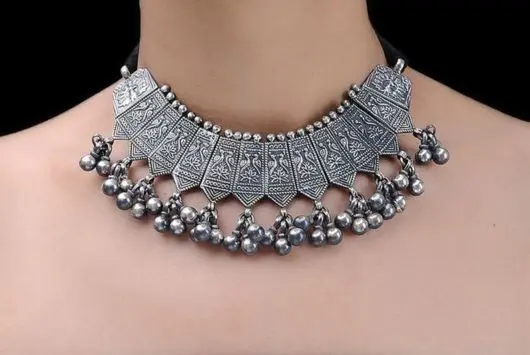SILVER JEWELRY
Silver jewelry specifications focus on the materials, quality, and characteristics of silver when used in jewelry-making. Here are the key specifications for silver jewelry:


1. Types of Silver Used in Jewelry
1.1. Sterling Silver
Purity: Sterling silver is the most commonly used type of silver in jewelry. It is composed of 92.5% pure silver and 7.5% other metals, usually copper, to enhance strength and durability.
Stamping: Sterling silver is often stamped with “925” to indicate its purity (92.5% silver content).
Durability: Sterling silver is durable, but not as hard as gold or platinum. Over time, it can develop scratches, but it can also be polished back to its original shine.
Tarnishing: Silver tarnishes over time when exposed to air and moisture, forming a dark, oxidized layer. This can be cleaned off with polishing or using anti-tarnish products.
1.2. Fine Silver
Purity: Fine silver is 99.9% pure silver. It is less alloyed than sterling silver, making it softer and more prone to scratching or bending.
Use in Jewelry: Fine silver is often used for intricate designs, such as filigree work or pieces that will be lightly worn, like earrings or pendants.
Tarnishing: Fine silver tarnishes more quickly than sterling silver due to its higher silver content.
1.3. Argentium Silver
Purity: Argentium silver is a modern type of sterling silver alloy that contains 92.5% silver with a small amount of germanium.
Tarnish Resistance: Argentium silver is highly resistant to tarnishing, making it more durable than traditional sterling silver.
Benefits: It has a whiter, brighter appearance and is a popular choice for modern silver jewelry.
1.4. Coin Silver
Purity: Historically, coin silver was made from melted U.S. coins containing 90% silver, but today it is an alloy of around 90% silver and other metals.
Usage: Coin silver is used less frequently in modern jewelry but can be found in vintage or antique pieces.
2. Weight and Durability
Density: Silver is relatively dense, giving jewelry a solid, substantial feel. However, it is softer than other precious metals like gold, platinum, or titanium.
Strength: Silver can withstand daily wear but is prone to scratching, denting, and bending more easily than harder metals. Its strength can be improved by alloying with copper or other metals.
3. Finish and Appearance
Shiny Finish: Silver jewelry often has a polished, shiny finish that gives it a sleek, clean look. Matte and Brushed Finishes: Some silver jewelry is intentionally left with a matte or brushed finish for a more modern or understated appearance.
Oxidized Silver: Oxidized silver jewelry has a darker, blackened appearance created through a chemical process, highlighting engravings or giving the piece a vintage, rustic look.
4. Design and Craftsmanship
Handmade vs. Machine-Made: Silver jewelry can be handcrafted by artisans, using techniques like casting, stamping, soldering, or engraving, or mass-produced by machines. Handmade silver jewelry is often more intricate, detailed, and unique.
Customization: Silver jewelry is highly customizable, with options for engraving, gemstone settings, and bespoke designs.
Setting Types: Silver jewelry can incorporate various gemstones, such as diamonds, sapphires, emeralds, and semi-precious stones. Common settings include prong, bezel, channel, and pave settings.
5. Common Jewelry Types in Silver
Rings: Silver rings are a popular choice due to their affordability, beauty, and versatility. They can feature gemstones or intricate designs like filigree or engraving.
Necklaces and Pendants: Silver chains and pendants come in various styles, from minimalist to ornate designs, often set with gemstones or pearls.
Bracelets: Silver bracelets range from delicate bangles to statement cuffs, with options for stone settings, charms, or engravings.
Earrings: Silver earrings, including studs, hoops, and drop earrings, are versatile and widely available, often set with diamonds or colored stones.
Brooches and Pins: Silver brooches can be highly decorative, often featuring intricate designs, gemstones, or artistic motifs.
6. Maintenance and Care
Cleaning: Silver jewelry can be cleaned with a polishing cloth, silver cleaner, or a mild soap and water solution. For tarnished silver, use a silver polish cloth or a solution of baking soda and water.
Storage: To prevent tarnishing, store silver jewelry in a cool, dry place, preferably in an anti-tarnish pouch or cloth.
Avoiding Tarnish: To reduce tarnishing, avoid exposing silver jewelry to chemicals, perfumes, lotions, or harsh cleaning products. When not in use, store silver jewelry away from air and moisture.
